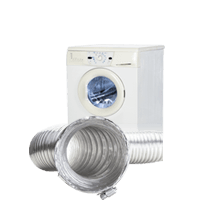Popular
New!
Residential A/C Cleaning FAQ Part 1
Answers to questions you may have had about cleaning your A/C system
Common Questions about Dryer Vents
Things you always wanted to know about dryer vents but were afraid to ask
Will this product help improve HVAC Efficiency?
A "New", but "Old" Product
Who knew the lowly dryer vent is so important?
What to look for when inspecting a dryer vent..
Go to Any Heights!
We go to the limit to get the job done.
Build it to Last!
We produce our work to last.
It's time to review IAQ!
Some simple advice regarding your Indoor Air Quality.
Fiberglass - Another Look!
Another look at the most popular insulation.
The Great Lightbulb Race!
An update on the better light bulb.
Combatting indoor allergies
Find out steps you can take to reduce suffering.
Plants and your indoor air quality
Reduce your volatile organic compound levels!
What's that Stuff in Your Air Ducts?
A common source of occupant complaints!
Handling Odors in Commercial Buildings
Ozone generators can help - with certain precautions.
How to choose a filter
Check out our chart.
Carpets and your indoor air quality
Keep them clean, keep them dry. Find out more.
To sanitize or not to sanitize.
Sanitizing is not always a good idea, find out why.
Mold inspections when buying a house
Find out what to look for.
Sick Building Syndrome
What is it and what can you do about it?
Now that the smoke has cleared.
How to handle IAQ problems after Southern California fires.
Indoor Air Quality and your Building.
What it REALLY takes to clean an air conditioning system!
See the pictures!
Fiberglass - Effects and Alternatives
OSHA - Find out what they have to say.
Shafted
We have said many times, “NOW we’ve seen it all!” only to stumble across something we’ve never seen before.
The Magic of Out Side Air
The secret to reduce toxins in your building.
The Purpose of indoor air quality investigations.
Hopefully it's not to take measurements and not resolve the situation.
Action to Take Before and Aftera Build-Out
After the build-out the area should be environmentally deep cleaned.
Ozone and Odors
Inherent instability of ozone is also the impetus behind its ability to neutralize odors.
What to do in the fires!
Think about getting some carbon filters
Dust - It's not just dirt!
It's skin flakes, fibers from clothes and more.
Humidity and Indoor Air Quality
Don't let humidy reduce your indoor air qaulity.
Going all the way with your indoor environment!
Find out what it takes.
Something's in the air - you know it!'
It's not just in your head.
Fresh Air - Keeping those employees conscious
They produce more when they're conscious.
Coils and Hygiene!
A common source of occupant complaints!
Coils, Coils, Coils!
Hygiene, energy efficiency and system longevity. Yes, they are important.
Drain Pans - how to handle
Rusty, corroded condensate pan?
Why air duct cleaning?
Let George Machado explain.
Understanding Mold
Buying a House
Is the house you are considering buying mold-free?
Handling Mold
The most effective way to deal with mold is to prevent water from entering the building envelope.
The dose makes the poison
Virtually any mold type can be allergenic to certain individuals.
The Mold Toxin Controversy
Mold spores are everywhere!
Mold Part 1
Nature's Recyclers.
Mold Part 2
Nature's Recyclers.
Tales from the field
Sound Proofing
An IAQ tail of too much sound proofing.
George the legend
George Machado and a new construction odor.
Clean Room Odor
Chasing the cause.
Tight houses
Great for energy efficiency - can be a problem for indoor air quality.
Odors
Unnecessary distractions
Other Topics
Electrostatic Filters
The pros and cons.
Legionaire's Disease Unraveled
Bacteria commonly found in water supplies. Sanitize those swap coolers.
Light Bulbs
Confused about the new laws about incandescent light bulbs?
Listeria Bacteria
Often in the news, find out more.
Cutting Heating and Cooling Costs.
Let technology take control.
Dust mites
They can cause a range of symptoms, find out what to do.
Energy Efficiency
... a new look.
History of Cool
- how did we get here?
Breathe Free or Die!
- Steve Huff's indoor air quality book
Southern California Molds
Aspergillus
Aspergillus is found under normal conditions in soil, decaying plant debris, compost piles and stored grain.
Penicillium
One species has even been detected in diesel fuel.
Stachybotrys
This is the infamous “black mold”.
Chaetomium
Found in soil, on cellulose materials, including woody and straw components and animal waste.
Ulocladium
Found under normal conditions in soil, animal waste products, grass, paint, paper, textiles, and decaying plant matter.
Cladosporium
Often a secondary invader following Penicillium and/or Aspergillus.
Aurobasidium
This is a yeast-like fungus. Early on it is cream color to pink, but grows much darker with age.
Indoor Air Quality Gases
Ozone
It has an odor generally described as a sharp pungent smell with some similarity to chlorine.
Natural Gas
Methane, Butane, Propane, Pentane and Ethane.
Methane
They add a smell to it so you don't ignore it!
Radon
Radioactive, colorless, odorless. It's a good idea to get it tested for.
Volatile Organic Compunds (VOCs)
New carpet, furniture and paint can off gas VOCs!
Hydrogen Sulfide
Rotten eggs smell, often from sewer gas.
Formaldehyde
Used in the production of pressed wood products like plywood and particle board.
Carbon Monoxide
It is a colorless, odorless gas. It is toxic to humans. It can be deadly at sufficient quantities.
Carbon Dioxide
State of California recommends that CO2 levels remain below 800 ppm.










